-
 In 1869, a biologist named Friedrich Miescher discovered what nucleic acids are.
In 1869, a biologist named Friedrich Miescher discovered what nucleic acids are. -
 Later Phoebus Leven discovered all the components of DNA and defined the unit including the sugar, the phosphate and the nucleotide which was the base. In the DNA there are four bases: adenine, guanine, thymine, cytosine and deoxyribose phosphate.
Later Phoebus Leven discovered all the components of DNA and defined the unit including the sugar, the phosphate and the nucleotide which was the base. In the DNA there are four bases: adenine, guanine, thymine, cytosine and deoxyribose phosphate. -
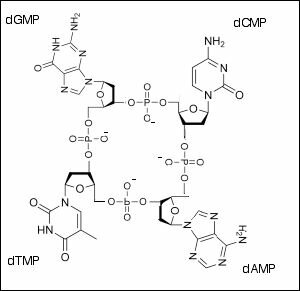 Leven said that there were four nucleotides per molecule and that this created a very simple structure that could not be the key to unlocking the inheritance. But Leven was wrong about in the theories.
Leven said that there were four nucleotides per molecule and that this created a very simple structure that could not be the key to unlocking the inheritance. But Leven was wrong about in the theories. -
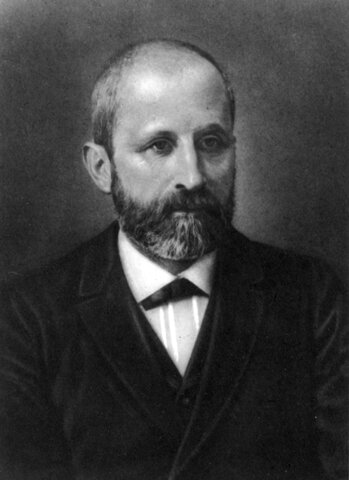 Frederick Griffith was a bacteriologist who studied the epidemiology and pathology of 2 strains of Streptococcus Pneumoniae. He was the first to demonstrate bacterial transformation. In January 1982 he presented the first accepted demonstrations of bacterial transformation.
Frederick Griffith was a bacteriologist who studied the epidemiology and pathology of 2 strains of Streptococcus Pneumoniae. He was the first to demonstrate bacterial transformation. In January 1982 he presented the first accepted demonstrations of bacterial transformation. -
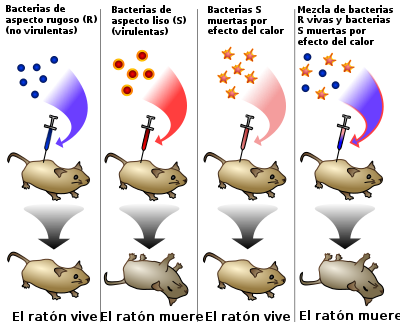 Griffith conducted an experiment in which he used two strains of Streptococcus:
Griffith conducted an experiment in which he used two strains of Streptococcus:
- Type S: virulent (deadly)
- Type R: non-virulent (harmless) -
 Oswald Avery, Colin MacLeod and Maclyn Mccarty did experiments to explain Frederick Griffith's results. They determined the cause of the transformation in the Griffith Experiment. They took live R and heat-treated S and mixed it with one of two enzymes:
Oswald Avery, Colin MacLeod and Maclyn Mccarty did experiments to explain Frederick Griffith's results. They determined the cause of the transformation in the Griffith Experiment. They took live R and heat-treated S and mixed it with one of two enzymes:
- Proteases that destroy protein
- DNase which destroys DNA They showed that the DNA was responsible for the transformation, because if you cut the DNA with the DNAase it is no longer virulent. -
 The article suggests that DNA, and not proteins, may be the hereditary material of bacteria, and perhaps also of higher organisms.
The article suggests that DNA, and not proteins, may be the hereditary material of bacteria, and perhaps also of higher organisms. -
 Watson and Crick proposed a first model in which they described DNA as a double helix with sugars and phosphates in the center and the nucleobases on the outside. This model they presented was incorrect, because it did not make any chemical sense.
Watson and Crick proposed a first model in which they described DNA as a double helix with sugars and phosphates in the center and the nucleobases on the outside. This model they presented was incorrect, because it did not make any chemical sense. -
 Chargaff did an experiment with two animals and two humans. When he looked at the results, he saw that the amount of adelin and thymine was always the same and that the amount of cytosine and guanine was also always the same. Chargaff shared his discovery with James Watson and Maurice Wilkins, at the Cavendish Laboratory. When they saw the experiment, they knew what it meant.
Chargaff did an experiment with two animals and two humans. When he looked at the results, he saw that the amount of adelin and thymine was always the same and that the amount of cytosine and guanine was also always the same. Chargaff shared his discovery with James Watson and Maurice Wilkins, at the Cavendish Laboratory. When they saw the experiment, they knew what it meant. -
 Erwin Chargaff started counting nucleases, emigrated to the United States and became a professor of biochemistry. While at Columbia University Medical School, he became interested in the percentages of different nucleases and noticed something strange. What he did was to look at different organisms and measure the quantities of the four bases: Adenine, Thymine, Cytosine and Guanine.
Erwin Chargaff started counting nucleases, emigrated to the United States and became a professor of biochemistry. While at Columbia University Medical School, he became interested in the percentages of different nucleases and noticed something strange. What he did was to look at different organisms and measure the quantities of the four bases: Adenine, Thymine, Cytosine and Guanine. -
 Alfred Hershey and Martha Chase did very surprising experiments with phages. What they did was to use a bacterial cell. Of course, the bacterium has its own nuclear material, and that's going to be the host. Then they took bacteriophages in two ways, one of them with radioactive sulfur, which allowed them to follow the proteins in the phage and the other one used radioactive DNA to be able to follow the movement of the DNA during infection.
Alfred Hershey and Martha Chase did very surprising experiments with phages. What they did was to use a bacterial cell. Of course, the bacterium has its own nuclear material, and that's going to be the host. Then they took bacteriophages in two ways, one of them with radioactive sulfur, which allowed them to follow the proteins in the phage and the other one used radioactive DNA to be able to follow the movement of the DNA during infection. -
 Hersey and Chase concluded that DNA, not proteins, was not the genetic material. A proactive protein coat formed around the bacteriophage, but the internal DNA is what gave it its ability to produce progeny inside the bacteria.
Hersey and Chase concluded that DNA, not proteins, was not the genetic material. A proactive protein coat formed around the bacteriophage, but the internal DNA is what gave it its ability to produce progeny inside the bacteria. -
 Linus Pauling was the one who discovered the structure of the three alpha helices and the beta sheets in proteins, he created a triple helix model with the phosphates and the sugar on the inside, and the nucleobases on the outside. But the experiment was again incorrect.
Linus Pauling was the one who discovered the structure of the three alpha helices and the beta sheets in proteins, he created a triple helix model with the phosphates and the sugar on the inside, and the nucleobases on the outside. But the experiment was again incorrect. -
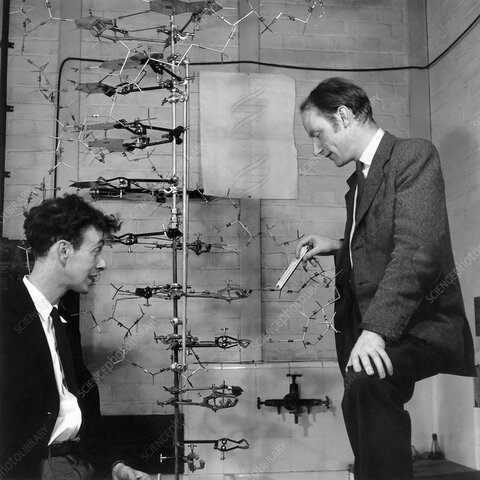 Francis Crick, James Watson and Maurice Wilkins worked at the Cavendish Laboratories in Cambridge. After Maurice Wilkins got the photo of Rosalind Franklin he showed it to Watson and Crick in Cambridge. When they saw the picture, they realized that the 1951 model was upside down. So they built a new model based on Franklin's picture.
Francis Crick, James Watson and Maurice Wilkins worked at the Cavendish Laboratories in Cambridge. After Maurice Wilkins got the photo of Rosalind Franklin he showed it to Watson and Crick in Cambridge. When they saw the picture, they realized that the 1951 model was upside down. So they built a new model based on Franklin's picture. -
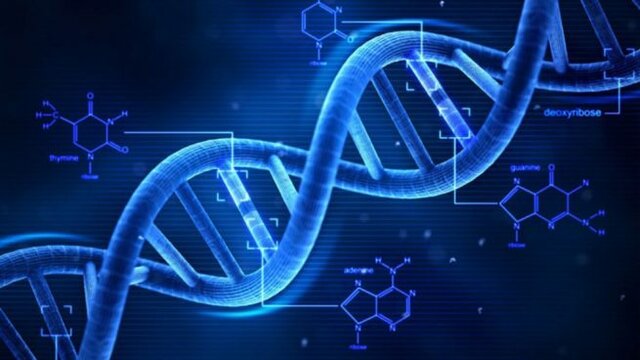 After several scientists explained and taught their theories about DNA, it is now known that the correct structure of DNA is a double helix structure. It is a sequence formed by sugar, phosphate and nitrogenous base groups. These nitrogenous bases are adenine (A), thymine (T), cytosine (C) and guanine (G). They always establish hydrogen bonds between A and T, and C with G, so the amounts between them always match.
After several scientists explained and taught their theories about DNA, it is now known that the correct structure of DNA is a double helix structure. It is a sequence formed by sugar, phosphate and nitrogenous base groups. These nitrogenous bases are adenine (A), thymine (T), cytosine (C) and guanine (G). They always establish hydrogen bonds between A and T, and C with G, so the amounts between them always match.